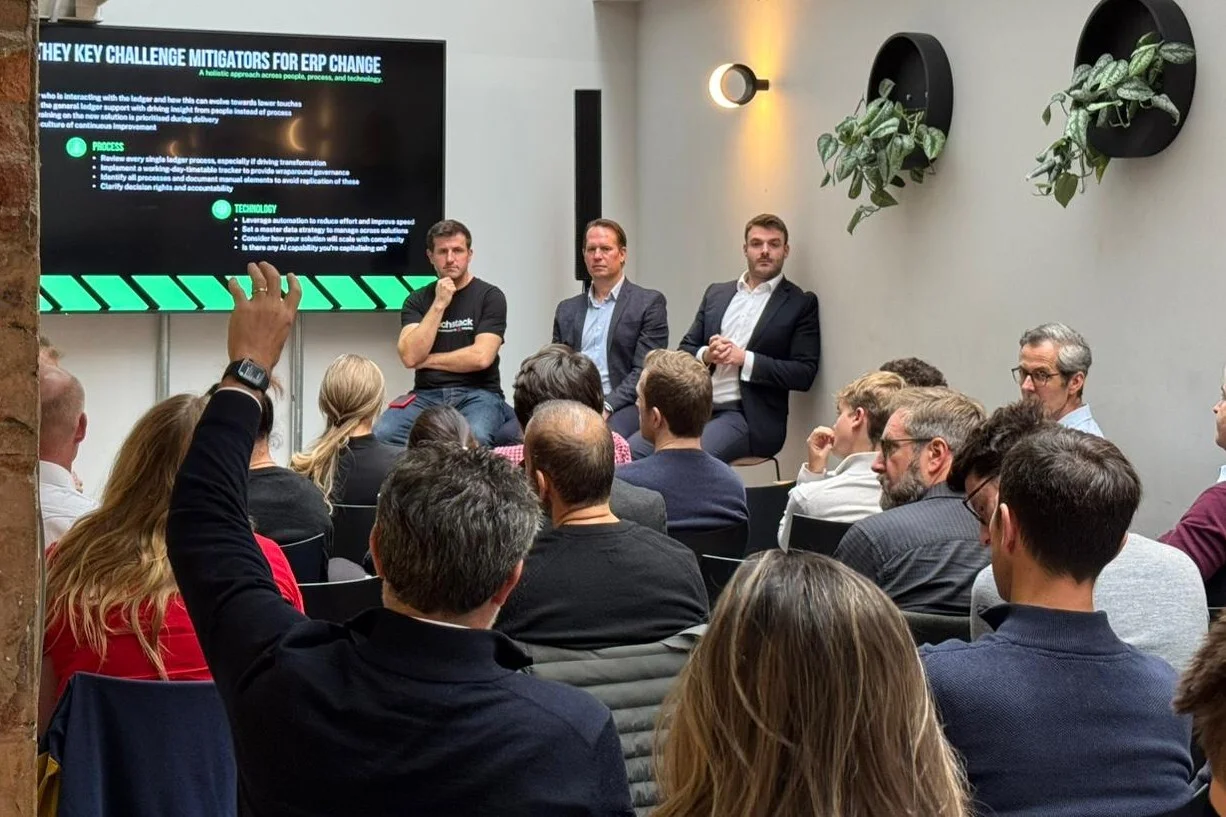
How AI-Native systems are challenging Legacy ERPs | What’s After Xero? (CFO Masterclass Recap)
29 Oct, 202512
What’s after Xero?
During our most recent CFO Masterclass, we explored one of the most pressing questions for scaling finance teams: how to know when Xero has reached its limits, and what comes next. The discussion brought together three experts with first-hand experience across every stage of the finance systems journey, from cloud accounting to enterprise ERPs and the next generation of AI-native tools.
David Tuck , Co-Founder and CEO of Mayday , shared his perspective as both a former CFO and a long-time accounting tech entrepreneur. At Mayday, they’ve helped over 12,000 Xero organisations mend month end and scale confidently without moving to an ERP. Mayday also created CFO Techstack, a content hub and community of over 5,000 finance leaders that showcases how modern finance teams extend Xero's lifespan with best-in-class ecosystem apps.
Rolf Buhler and Matt Benaron from VantagePoint brought the complementary enterprise lens. Together, they’ve advised and implemented systems like Sage Intacct, NetSuite, and Microsoft Dynamics for scaleups and corporates alike. Their focus is on helping CFOs design the right finance architecture for their next phase of growth, balancing pragmatism, readiness, and return on investment.
Across the session, the group tackled key questions:
- How scaling businesses are maximising Xero’s potential.
- The early warning signs that it’s time to move on.
- How to manage migration risk and system selection.
- Whether traditional ERPs are evolving fast enough to keep up with AI-led innovation.
- And what the new generation of AI-native finance platforms could mean for the future of finance technology.
And we have pulled those insights into a thorough recap guide, for CFOs deciding when (and how) to evolve their finance stack.
How are finance teams maximising Xero as they grow?
The finance teams getting the most from Xero treat it as the scalable core of their tech stack rather than a small-business accounting system you’re meant to grow out of. By integrating specialist apps for month end, spend management, consolidation, payroll, and reporting, they create lean, connected finance functions with real-time visibility and control, all without the overhead of an ERP.
As David Tuck, Co-Founder and CEO of Mayday, put it, “What comes after Xero is more Xero, with a best-in-class tech stack around it.”
Drawing on his experience helping thousands of finance teams automate processes and extend Xero’s capabilities, David noted that most businesses can go much further with Xero than they realise. Its strength as a general ledger, combined with the power of its open API and connected ecosystem, enables scaling with agility and accuracy long before an ERP is needed.
“At Mayday, we see it first-hand,” he explained. “We have 46 customers with revenue over $100 million, and another 62 between $50 and $100 million, all running on Xero, not ERP.”
These stacked finance teams build best-in-class systems using tools like ApprovalMax for AP, Syft Analytics, Fathom or Joiin for reporting and Mayday for automation across intercompany, revenue recognition, and prepayments, turning painful month-end processes into one-click workflows.

Through the CFO Techstack community, now connecting more than 5,000 finance leaders, David and the Mayday team continue to champion this “stacked” Xero model, helping CFOs identify the right combination of tools to extend Xero’s lifespan and scale confidently without an ERP.
Should finance teams keep layering best-in-class tools around Xero, or move to something more powerful?
The “Xero plus ecosystem” approach remains the foundation for many scaling businesses, but how finance teams use that setup is rapidly evolving. Instead of replacing Xero or QuickBooks with a single, all-encompassing ERP, more CFOs are focusing on integration maturity: making the tools they already use work smarter together.
As Mayday’s David Tuck explained, the average Xero-based finance stack includes around six to seven connected apps covering functions such as consolidation, approvals, and spend management. He added that over the next year, these stacks are likely to evolve beyond fragmented add-ons into more cohesive, automated ecosystems.
With automation, APIs, and AI-driven connectivity advancing so quickly, many finance leaders now see even greater upside in strengthening their existing tech stack rather than moving to an ERP prematurely. The connected-stack model offers the same visibility and control, but with lower cost, faster iteration, and greater flexibility to evolve.
In this more integrated future, mapping intercompany loan accounts in Mayday could automatically feed into a consolidation platform, or purchase orders raised in ApprovalMax could inform accrual recommendations, removing duplication and improving accuracy as integration maturity advances.
Ultimately, the answer for most scaling teams isn’t to move away from Xero, but to move deeper into it, building a best-in-class, connected ecosystem that grows with the business rather than against it.
How do you know when Xero has reached its limits?
There’s no single revenue figure that signals it’s time to move on, but a combination of factors often drives the shift. Instead of focusing purely on scale, finance leaders should look at where value and data flow start to break down, the points where processes become slower, more manual, or less reliable.
In practice, most companies reach an inflection point when they’ve explored the full potential of Xero’s ecosystem and still can’t address key operational needs. These tend to fall into three main categories:
- Transaction volume: When day-to-day processing becomes too heavy for Xero’s infrastructure.
- Tracking categories: Xero’s two-category limit constrains complex reporting structures, especially for multi-entity or multi-department organisations.
- User permissions: Highly regulated businesses may need more granular access controls than Xero can offer.
While there are creative workarounds, such as using Cin7 for manufacturing, A2X for eCommerce, or advanced reporting tools that extend Xero’s data dimensions, these eventually hit a ceiling. Once fixes start compounding complexity rather than solving it, it’s a clear signal to start planning your next move.
As Rolf Buhler and Matt Benaron from VantagePoint highlighted, success isn’t about jumping ship quickly but about understanding why you’re moving. Their experience helping CFOs select and implement Enterprise Resource Planning Systems like NetSuite, Sage Intacct, and Dynamics shows that the best transitions happen only once the gaps are clear, persistent, and genuinely slowing down decision-making, not simply because the business has grown in size or complexity.

What should finance leaders consider before migrating to an ERP?
When a move does become necessary, planning is everything. Ensure you step back and define the vision for finance before choosing a system. Whether the goal is to run a lean, efficient finance function ahead of an exit, or to build a fully integrated, insight-driven architecture for long-term growth, that vision should drive the choice of platform.
Key considerations include:
- Data model and chart of accounts: Many teams find that their Xero setup has evolved organically, making it essential to review how the data model aligns with current reporting needs before migration.
- Historical data: Transferring and reconciling past data can be the most resource-intensive part of an ERP project, often more so than setting up the system itself.
- Scope of the ERP: Traditional ERPs were designed to manage everything, inventory, logistics, supply chain, in one place. Modern systems, however, increasingly operate as hubs that integrate best-in-class specialist tools.
- Automation and integration strategy: Even with a new ERP, automation remains critical. Teams should plan how data will flow between systems and how manual reconciliations can be reduced.
What are the most common mistakes when transitioning to an ERP system?
The biggest mistake companies make is approaching migration as a technology upgrade rather than a business transformation. Before starting the process, finance leaders need to define what success looks like and ensure the new system is aligned with long-term goals. Without this clarity, it’s easy to choose a platform that solves the wrong problems or fails to scale with the business.
As VantagePoint noted during the session, the most successful transitions start with a clearly defined roadmap. Their team has seen too many businesses move to an ERP simply because they felt they had outgrown Xero, only to realise halfway through that their future reporting, data, or compliance needs hadn’t been properly mapped.
Insufficient due diligence is another common issue. Many teams jump straight into a well-known ERP without properly evaluating functionality, integrations, or scalability. As Rolf highlighted, due diligence isn’t just about comparing features, it’s about understanding dependencies and ensuring the system will still serve the business two to five years from now.

How can CFOs design ERP systems that stay flexible as the business grows?
Heavy scripting and point customisations create stickiness that is hard to unwind. Design for graceful exit on day one. Standardise master data codes across systems, centralise mappings in a separate tool, and prefer configuration over code where possible. Use APIs and low-code automation for calculated fields and cross-system updates so logic is portable. Out-of-the-box features rarely fit every edge case. The goal is controlled extensibility that does not trap you.
These principles matter because many legacy ERPs became “sticky” not through excellence, but through accumulated complexity, custom scripts, dependencies, and consultants that make migration painful. The new generation of AI-native tools offers cleaner implementation paths, but the same caution applies.
What should CFOs consider when comparing systems?
A growing question among finance leaders is whether traditional ERPs are evolving fast enough to keep pace with automation and AI. While newer tools are iterating rapidly, established systems like Sage Intacct and NetSuite are investing heavily to close the gap, releasing frequent updates, embedding AI capabilities such as predictive forecasting and natural language queries, and reducing the need for major upgrade projects.
The comparison, however, isn’t just about technology maturity. It’s about aligning the system’s design with your organisation’s scale, data discipline, and risk appetite.
Legacy ERPs offer proven depth, auditability, and control, whereas AI-native platforms like Light, Campfire, and Rillet emphasise usability, automation, and speed of iteration. The challenge for CFOs is determining whether these newer entrants can match the robustness of established systems across areas such as revenue recognition, audit trails, and multi-entity consolidation.
Platform risk also deserves attention. Finance leaders should plan for continuity by syncing their full data schema and transaction history to a separate database. This preserves flexibility if a vendor fails or strategy shifts. Even with long-standing providers, the same principle applies: own your data, maintain reproducible exports, and document how core records can be ported elsewhere.
What should CFOs expect from an AI-native platform?
As AI-native tools gain traction, CFOs are beginning to explore what these new systems can realistically deliver, and where they still fall short. Built with embedded intelligence rather than bolt-on automation, they learn, adapt, and execute directly within the ledger.
- Light uses a natural language engine to define revenue recognition rules in plain English and automate compliance.
- Campfire focuses on structured contract management for SaaS businesses managing recurring revenue and deferred income.
- Rillet embeds automation throughout every transaction and decision layer.

While these platforms offer major usability and efficiency gains, they remain early in their lifecycle. Many focus on revenue recognition and reporting but lack the audit depth and ecosystem maturity of established ERPs. For now, most CFOs are taking a hybrid approach, remaining on trusted platforms that continue to evolve while monitoring the rapid progress of AI-native solutions that are reshaping finance technology.
AI-native ledgers also aren’t necessarily cheaper. Pricing varies by vendor and can be based on entities, users, or transaction volume. Xero remains the most cost-effective option, while newer platforms often price in line with Sage Intacct and NetSuite once connectors and implementation are included. Effective procurement makes a significant difference: quarter-end negotiations and structured selection processes can materially reduce cost. Contract terms should also be agreed upfront, including commitment length, module flexibility, and exit clauses.
Ultimately, the right choice depends on your company’s stage, complexity, and strategic horizon. The goal isn’t to chase innovation for its own sake, but to select a platform that can scale, integrate cleanly, and evolve as the business grows.
Can AI-native systems catch up with decades of ERP development?
Innovation cycles are measured in months, but accounting depth is built over years. New entrants can move quickly on user experience, natural language workflows, and targeted automation such as revenue recognition. The hard part is comprehensive coverage across edge cases, auditability, and durable performance at scale. Depth accumulates through thousands of customer scenarios, not just funding. The near-term advantage for AI-native systems is usability and speed of change. The enduring advantage for mature ERPs is completeness and battle-tested controls. The pragmatic path is to adopt AI-native capabilities where they create real leverage while maintaining a clear data model, clean integrations, and an exit-ready architecture.
What determines the right system choice for scaling businesses?
As these systems continue to evolve at different speeds, the real question for CFOs becomes how to decide which path best fits their organisation. Choosing the right system depends on a company’s structure, growth trajectory, and internal capabilities. Predictable, single-entity organisations operating within one geography can often continue scaling successfully on Xero with the right stack of supporting tools. In contrast, multi-entity, multi-geography businesses, or those preparing for investment or acquisition, may need the depth and control of an ERP sooner.
Several factors influence the right decision:
- Complexity and scale: High transaction volumes, diverse revenue streams, or complex consolidation requirements may warrant an ERP.
- Data architecture: Businesses with mature finance teams often prefer modular ecosystems that maintain flexibility, while smaller teams benefit from the simplicity of an all-in-one ERP.
- Implementation effort: Even a lean ERP implementation typically takes at least three months, with around half of the effort falling on the finance team. Larger projects can extend up to two years depending on scale and resource availability.
- Capability and control: Teams with strong data fluency can make better use of multi-system architectures, while less mature teams may benefit from the structure of a single ERP environment.
Ultimately, the right choice depends less on cost or brand and more on readiness. A finance team that understands its data model, reporting requirements, and long-term strategy will select the platform that fits both current needs and future goals. But even the best-chosen platform won’t deliver results without the right people and processes behind it.

What truly drives success after a system change?
Technology choices matter, but outcomes are ultimately determined by people and process. The strongest finance functions cultivate data-oriented teams, continuous improvement habits, and a willingness to challenge the status quo. Implementing a new system without building data literacy or ownership quickly leads to stagnation, regardless of the platform.
System change is rarely just a technology challenge. Successful migrations depend on the team’s capability to understand data flows, redesign inefficient processes, and adapt to new tools. A technically sound implementation can still fail if the finance team lacks confidence in data interpretation or if leadership doesn’t reinforce a culture of continuous optimisation.
Reliable, well-structured data is the foundation for automation and AI. Without trustworthy inputs, intelligent systems produce unreliable outputs. Teams should obsess over process efficiency and eliminate unnecessary manual steps before expecting technology to solve underlying workflow issues. Continuous review, measurement, and iteration ensure the finance function evolves alongside the tools it uses.
When is the right time to evolve your finance system?
There is no perfect moment to switch platforms. New tools will continue to emerge, and capabilities will keep advancing. The key is to start with the end in mind and design an architecture that can evolve. Define the long-term vision for finance, align the data model with strategic reporting goals, and make deliberate decisions about integration boundaries.
Organisational realities also play a role. Auditor expectations, board confidence, and internal expertise all influence timing. Businesses that invest early in clean data and modular system design are best positioned to adapt as new AI capabilities appear.
Agent-based automation is already enabling low-code connections between systems, reducing the risk of early adoption. Progress made now, guided by a clear end goal, is more valuable than waiting for the next breakthrough. What matters is not when change begins, but how deliberately it is executed.
Conclusion
This discussion, drawn from our recent CFO Masterclass, revealed that there’s no single “right” moment or platform for scaling finance systems, only the right approach. Whether teams continue maximising Xero’s ecosystem, prepare for ERP migration, or explore the potential of AI-native ledgers, success depends on clarity, readiness, and adaptability.
As our panellists from Mayday and VantagePoint emphasised, technology alone doesn’t create transformation. The finance teams that thrive are those that invest in clean data, strong processes, and people capable of navigating change. Tools may evolve rapidly, but the fundamentals of control, insight, and decision-making remain constant.
For today’s CFOs, the challenge is not choosing between old and new but designing a finance architecture that can flex and scale as innovation accelerates. The systems may change, the strategy behind them shouldn’t.


